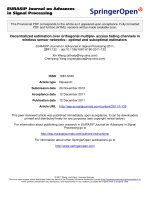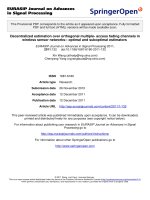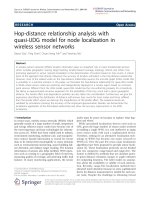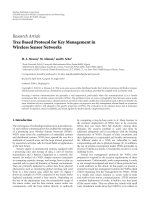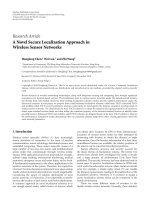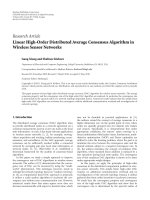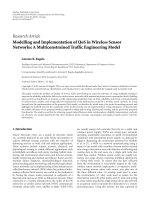Communication-Aware Route Selection in Wireless Sensor Networks
Bạn đang xem bản rút gọn của tài liệu. Xem và tải ngay bản đầy đủ của tài liệu tại đây (501.56 KB, 12 trang )
Communication-Aware Route Selection
in Wireless Sensor Networks
Adnan Fida1 , Pham Duy Hung2 , Nor Jaidi Tuah1 , Trung Dung Ngo1
1
2
University of Brunei Darussalam, Brunei Darussalam
The More Than One Robotics Laboratory
www.morelab.org
University of Engineering and Technology, Hanoi, Vietnam
Abstract. We consider the problem of optimal route selection with the
presence of path loss, multipath fading, interference, and environmental noise in wireless sensor networks. The communication-aware route
selection strategy is proposed by incorporating realistic communication
model portraying the underlying dynamics of wireless links. The link
quality is characterized by probability of successfully received packets
over a communication link, so-called reception probability. We utilize reception probability as a metric for communication quality oriented route
selection and compare its performance with the conventional metrics i.e.
Hop count and Euclidean distance. The simulation results demonstrate
that reception probability based route selection provides optimal end-toend throughput in wireless sensor networks.
1
Introduction
Recently, we have witnessed substantial interests in utilization of mobile platforms mounted with sensors and wireless modules for various applications such
as rescue operations [3][4][5], target tracking [2], and environment observations
[6]. Such systems are in general defined as mobile sensor networks, where mobile nodes perform two primary tasks: environmental data collection by selfnavigation; data transmission through multihop wireless networks.
In the scope of this paper, we assume that mobile sensor nodes have reached
their targets and collected environment exploited data through their sensing
capacity. Collected information must be transferred to base station or peer nodes
through self-organised ad hoc networks where nodes act as routers forwarding
data through the selected route [7]. The quality of service in such networks
primarily rely on reliability of wireless communication links constituting the
route. Selecting optimal route with the highest quality of communication is the
main objective of this paper.
The conventional route establishment schemes in multihop networks are
based on simplified link models such as binary link model where nodes perfectly
communicate within a transmission radius and nothing at all is communicated
outside that radius [18]. Slightly refined approaches considers disk graph models
where signal strength decays according to path loss and successful transmission
is possible within a deterministic transmission radius [8] [9] [10]irrespective of
wireless link conditions. These simplistic assumptions of disk models yields unrealistic inclusions with well documented limitations as explained in [1]. The
route selection metrics based on such communciation models does not generate
routes with high throughput in realistic scenarios as it neglects the sensitivity
of wireless links in terms of noise, fading, and accumulated interference[11]. The
Quality of Service (QoS) such as high throughput, and reliability is a crucial
requirement for such multihop sensor networks.
In recent research trends, incorporating link quality with route selection has
been considered. In [23], link quality estimation based routing protocol is proposed, which utilizes the link information recorded using the dynamic window
concept. Sequential Assignment Routing (SAR) presented in [24] incorporates
QoS in its routing decisions. However, such works do not consider the drastic
effects of fading and Interference on the link quality.
In this paper, communication-aware route selection scheme is proposed to
estimate the quality of realistic communication links using reception probability.
This scheme utilizes reception probability as a route selection metric to search
for a route with high end-to-end throughput in wireless sensor networks. We
consider the inherent uncertainty of wireless communication link caused due to
noise, interference, path loss and multipath fading. The integration of realistic
communication model and route selection is necessary to realize the full potential
of data communication in wireless sensor networks.
2
Conventional Route Selection Metrics
The routes for data communication are determined on the basis of route selection metrics. Most of the existing metrics such as hop count (HC) and Euclidean
distance (ED) adapted for route selection are borrowed from ad hoc wireless networks . We examine the end-to-end throughput performance of such metrics in
comparison with the proposed metric of reception probability (RP). The reception probability metric is presented in details in section 3.2.
2.1
Hop count(HC)
This metric is based on the concept of ideal communication link model i.e. either
communication is perfect or there is no communication at all. The idea is to
minimize number of hops on the route between a source and a destination. The
implementation simplicity makes hop count the most widely used metric in ad
hoc networks [20][21]. Its simplicity lies in the fact that computing the hop count
does not require any additional measurements as compared to other metrics
because hop count metric selects the optimal route with all the links with the
same quality. However, in realistic scenarios the link quality varies, thus route
selection based on hop count metric does not guarantee the most optimal route
found because a route with more hops might provides better throughput [17].
2.2
Euclidean Distance (ED)
Geographical position is another popular approach for route selection in ad hoc
wireless networks [22]. The usage of Euclidean distance (ED) as route selection
metric requires that every node knows its physical position as well as positions of
its neighbors. From the perspective of wireless link quality, this approach relies
on disk graph models with only consideration of the path loss due to distance.
ED-based route selection overlooks the fact that link quality can be dramatically
changed over small distances by environmental noise, interference and multipath
fading effects in indoor and urban environments.
3
Communication-Aware Route Selection
Considering a team of N mobile sensor nodes spatially distributed to jointly
perform a task in a given environment, they have reached specific targets and
each node requires sharing the information with all other nodes in the network.
Note that we use the terms ”node” and ”router” interchangeably in this paper,
in which node is used as general term for any nodes in the network while router
is used for nodes on selected routes between a source and a destination. We
assume that nodes remain static during the period of information sharing and
each node has its own unique ID. There are more than one routes available for
data transmission between a source and a destination. The objective is to find
the optimum throughput routes to all destinations. The solution to problem of
optimal route selection out of many available routes in realistic communication
environment involves two steps:
– Find a suitable metric to represent link quality in realistic communication
environment that take multipath fading, interference, and noise into account.
– Find optimal routes based on the selected metric.
3.1
Link Model
We assume a narrowband multipath fading wireless communication link. The
link is modelled as the multiplicative Rayleigh flat fading with an additive white
Gaussian noise (AWGN) process and large scale path loss exponent α [12]. Each
transmitted signal reaches the destination via random number of multiple paths
with no dominant line of sight (LOS) signal. The received signal is corrupted
by M interference signals and AWGN noise process. The variance of noise process is denoted by No and P denotes the transmission power of all the nodes.
The distance between a transmitter and a receiver is denoted by dD and distance between an interferer and a receiver is denoted by dm . Under the Rayleigh
flat fading link model, the received power R and interference power Im are ex−α
−α
¯ = Po dD
and I¯m = Po dm
valid for
ponentially distributed with R
do
do
dD , dm > do , respectively. do is the reference point located in far field of transα
λ
mit antenna and Po is the average power at do given as Po = P 4πd
. The
o
Signal-to-Interference-and-Noise-Ratio (SINR) denoted by ζ, is a discrete random process given by:
R
(1)
No + I
The SINR can be factorized into signal-to-interference-ratio (SIR) and signalto-noise-ratio (SNR). For link between any two nodes i and j, SNR is the ratio
¯
of meant received power to meant noise power, given by ζij = NRo and SIR is the
ζ=
ratio of meant received power to meant interference power, given as ζm =
dD
dm
−α
. The cumulative density function F (ζ) for SINR is given as [14]:
M
−ζ
1
F (ζ) = 1 − e ζi j .
ζ
m=1 1 + ζm
¯
R
Im
=
(2)
In order to mitigate the effects of interference, a slotted ALOHA scheme is used
such that for each time slot, each node transmits independently with a certain
transmission probability [15]. In (1) ,I is the accumulated interference power at a
M
receiver given by I = m=1 Bm Im . The transmission probability pt is assumed
as a Bernoulli distribution such that Bm is a sequence of independent Bernoulli
distributed random variable with IP(Bm = 1) = pt and IP(Bm = 0) = 1 − pt .
3.2
Reception Probability metric (RP)
The quality of wireless communication link can be determined by observing the
instantaneous SINR(ζ) between two nodes. Generally, outage probability [13]
is used to estimate the link quality and is defined as the probability that instantaneous SINR (ζ) falls below a certain threshold ζt . Consequently, a packet
will be successfully received if ζ ≥ ζt , the probability that instantaneous SINR
between two nodes is high above a certain threshold ζt is called reception probability denoted by pr := IP [ζ ≥ ζt ]. The value of ζt depends upon the modulation
and coding sheme [19]. Reception probability of slotted ALOHA under Rayleigh
fading channel is calculated using equation (2), and [16] shows that it can be
I
factorized into reception probabilities of noise-only pN
r , and interference-only pr
networks given as:
pr := IP [ζ ≥ ζt ] = 1 − F (ζ)
= exp −
= exp −
ζ t No
Po ddDo
= exp −
−α .
dD
do
M
.
1
ζt
1
+
ζm
m=1
M
IP (Bm = 1) .
m=1
ζ t No
Po
ζt
ζij
−α .
M
pt
m=1
1
+ IP (Bm = 0)
1 + ζζmt
1 + ζt
dD
dm
α
+ 1 − pt
= exp −
ζt No
dD
do
Po
pt ζt
1 −
−α
M
ζt +
m=1
α
dm
dD
(3)
pIr
pN
r
The proposed scheme uses the Reception Probability (RP) given in (3) as
route selection metric. This metric estimates the quality of realistic links with
path loss, multipath fading, noise and interference effects. The metric is further
investigated by simulating the behavior of pN
r as a function of SNR threshold and
distance between two nodes as shown in Fig.1(a). It is observed that pN
r decreases
as the distance between nodes increases. The results also show that reception
probability is inversely proportional to the SNR threshold. Fig.1(b) shows the
relationship between pN
r and number of multipath in the link between nodes.
It is noticed that reception probability decreases as the number of multipath
increases between two nodes. The values assigned to parameters for obtaining
these results are mentioned in Table.1.
1
No of Paths=3
No of Paths=4
No of Paths=5
No of Paths=6
No of Paths=7
No of Paths=8
0.9
1
RP (Noise Only)
RP (Noise Only)
0.8
0.8
0.6
0.4
0.2
0
5
0.7
0.6
0.5
0.4
0.3
0.2
0.1
2
10
3
SNR Threshold (dBm)
4
15
5
Distance (m)
(a) Distance (1-5m), SNR threshold
(5-15 dBm)
0
1
1.5
2
2.5
3
3.5
4
4.5
5
Distance (m)
(b) Number of multipath (3-8)
Fig. 1. Reception Probability (Noise Only).
3.3
Route Computation
All the routing schemes essentially rely on certain types of efficient shortest path
algorithms such as Bellman-Ford or Dijkstras algorithm for route computation.
These efficient algorithms are used to find the minimum weight routes based
on given metric. In case of communication aware route selection, we need to
find the route with the highest reception probability. The end-to-end reception
probability for a route is the product of every independent reception probability
of individual links comprising the route. After computing reception probability
for each link, we take negative logs of these probabilities to turn multiplication of
probabilities into addition of non-negative weights. Dijkstras algorithm is then
used to compute the minimum weight routes which correspond to routes with the
highest reception probability. The routes for HC-based and ED-based schemes
are also computed using Dijkstras algorithm for comparison.
4
Performance Evaluation
The aim of our simulation is to evaluate the effectiveness of communicationaware route selection in finding optimal throughput routes. We also quantify
the benefits of using RP as route selection metric over ED and HC for realistic
communication model.
4.1
Performance measure:
Throughput is a conventional estimate for the amount of traffic delivered by the
network [10]. We define the normalized throughput as the expected number of
successful packet transmissions for a given node per time slot [17]. This normalized throughput can be thought of as fraction of time a channel is utilized. We
consider end-to-end throughput over a multi-hop connection as the performance
measure for a route. The end-to-end throughput for route is defined as the minimum of throughput values of the links involved in constituting the route. The
throughput for each link between nodes i and j is given by:
T P (i, j) = pt (1 − pt ) × pr
(4)
Where pr is the reception probability as given in equation (3), pt is the
probability that i transmits and (1 − pt ) is the probability that j does not
transmit in the same time slot. The probability of transmission pt in each time
slot depends on the number of interferers on that particular link.
4.2
Simulation Setup
In all simulations, 200 nodes are randomly placed within a 50 by 50 (m) two
dimensional square region. We make following operational assumptions underlying the development of proposed scheme: a) every node is static with has a
unique ID, b) every node knows the relative distance to its neighboring nodes.
The values selected for parameters in Table.1 to obtain numerical results for RP
metric in equation (3) are representative of the real world low power wireless
networks[25].
4.3
Results from illustrative scenarios
Simulation 1. One-to-All: We first consider the scenario shown in Fig.2, where
a source node require routes to all other nodes in network. The node-91 is randomly picked as source node and routes to all other nodes are selected by applying three route selection metrics i.e. RP, ED, and HC.
Table 1. Values for parameters used in simulation
Parameter
Description
P
Transmit Power
No
Noise Variance
ζt
SINR Threshold
λ
Wavelength
α
Path loss exponent
Value
0 dBm
-85 dBm
10 dBm
0.12 m
4
Fig. 2. Wireless network of 200 node with source node-91 (red), routes to all other
nodes are selected using RP, ED, and HC metrics.
Fig. 3 compares the median end-to-end throughput, number of hops and
euclidean distance for 199 routes selected from source node-91 to all other destination nodes in the network. We choose median to analyze the data instead
of mean because the data distribution is quite skewed. In each box shown in fig
3 , the central mark represents median and difference between edges of the box
represent the inter-quartile range (IQR). IQR is used to measure the dispersion
of data and is defined as difference between 25th and 75th percentile of the data.
The median end-to-end throughput is 0.0289, 0.0175, 0.0170 for RP, ED
and HC based routes respectively. The results show that routes selected using
RP metric have higher throughput than routes found using conventional ED
and HC metrics. In this typical case, RP-based route selection offers about 65%
median throughput gain as compared to ED-based routes and 70% higher median
throughput than HC-based routes. The median of the hops taken by RP, ED and
HC based routes are compared in Fig. 3(b). Intuitively, the HC metric takes the
minimum median of hops i.e 9 as compared to 10 for ED and 12 for RP-based
routes. The routes selected by RP metric tend to comprise of more hops than
either of the other metrics if each selected hop also provides higher throughput.
The median Euclidean distance for all routes is slightly less for ED-based routes
in comparison to RP and HC as shown in Fig. 3(c).
(a) Median Throughput
(b) Median Number of
Hops
(c) Median Euclidean
Distance
Fig. 3. Throughput, number of hops, and Euclidean distance for 199 source-destination
routes
Simulation 2. One-to-One: We investigate a single source-destination case
and analyze the route selection procedure for different metrics. The end-toend throughput comparison is performed for RP, ED and HC-based routes selected for randomly chosen single source-destination pair (node-110-to-node-91)
as shown in Fig.4.
Fig. 4. Wireless network of 200 nodes with routes selected from source node-110(red)
to destination node-91(green) using RP (red route), ED (cyan route) and HC (magenta
route).
Fig.5(a) shows the achievable end-to-end throughput for the routes selected
by each metric, RP metric outperforms the other two metrics. The end-to-end
throughput of the route using RP metric is 0.025, while the routes based on ED
and HC metric achieves 0.021 and 0.015 respectively. The end-to-end throughput
gain for RP-based route is 20% and 66% more than ED and HC. Number of hops
on each metric is presented in Fig.5(b). As expected, the HC metric chooses the
shortest route between the source and the destination with lowest number of hops
i.e. 18 but minimizing the hop count does not necessarily increase the throughput
in realistic communication scenarios. Fig.5(c) shows that the RP-based route
metric enables the longest distance while the ED-based route selection finds the
route with minimum distance.
Throughput
0.02
0.015
0.01
0.005
0
RP
ED
HC
Euclidean Distance (m)
25
Number of Hops
0.025
20
15
10
5
0
RP
Metric
(a)
End-to-end
Throughput
ED
HC
Metric
(b) Number of Hops
100
80
60
40
20
0
RP
ED
HC
Metric
(c) Euclidean Distance
Fig. 5. Throughput, Number of hops and Euclidean distance for a single sourcedestination pair
We observe in Fig.4 that other than two extra hops made by RP-based route;
both RP and ED-based routes follow the same hops. The first extra hop comes
very near to the source node where ED-based route goes directly from node10 to node-119, whereas RP-based route makes an extra hop i.e. 10-109-119.
The other extra hop occurs near the destination where ED-based route follows
165-65-64, while RP-based route takes the path of 165-166-164-64. In order to
further investigate the reasons for these route diversions, we compare the reception probabilities (RP), throughput (TP) and Euclidean distances (ED) for
these individual hops/links in Table 2.
Table 2. Comparison of RP, HC and ED(m) for selected hops on RP-based and EDbased routes.
10-109-119
10-109 109-119
RP
0.19 0.75
0.37
TP 0.021 0.120 0.046
ED(m) 3.824 1.098 2.753
Hops 10-119
165-65-64
165-166-164-64
165-65 65-64 165-166 166-164 164-64
0.40 0.31 0.37
0.53
0.52
0.045 0.034 0.060 0.065 0.064
2.799 3.907 2.048 2.358 2.655
In first route diversion for RP-based route, we observe that combined reception probability for 10-109-119 is 0.28 as compared to 0.19 for single hop case
10-119 in ED-based route. RP metric based route chooses the link with higher
reception probability resulting in higher throughput. Similarly, in second diversion near the destination, ED-based route selection scheme chooses 165-65-64
because of the small combined distance of 6.70(m) as compared to 7.06 (m)
for 165-166-164-64 chosen by RP-based scheme. RP-based scheme considers the
stochastic nature of wireless links, whereas ED and HC based schemes select the
route irrespective of condition and realization of wireless links.
Simulation 3. Dense Network: In order to further validate the proposed
RP-based route selection scheme, we compare its performance with ED and HC
in a much denser network where nodes are closely spaced and interference is
high as shown in Fig.6. Node-195 is randomly picked as source with routes to
all the other nodes in network. The median throughput, median number of hops
and median euclidean distance for all the routes selected by different metrics are
shown in Fig. 7. Results in the dense network provide evidence that RP-based
Fig. 6. Dense network of 200 nodes with source node-195(red), routes to all other
nodes are selected using RP, ED, and HC.
routes surpasses the ED and HC based routes in terms of end-to-end throughput.
Fig.7(a) shows that routes selected using RP provides a gain of about 50% in
end-to-end median throughput as compared to the conventional metrics based
on simplistic communication models. In dense networks, RP-based routes travels
almost double number of hops i.e. 8, as compared to HC and ED (number of hops
= 4) as seen in Fig.7(b). Intuitively, it seems that RP is higher at small distances
but in reality it can be vice versa as it considers all the dynamics of wireless
channel such as path loss, noise, interference and multipath fading. Fig.7(c)
depicts that Euclidean distance for three metrics remains almost same in dense
networks. The RP metric produces longer hops and travels more distance than
both ED and HC metric but manages to provide higher throughput in realistic
environment by considering the uncertainty of wireless links and choosing the
high quality links with optimized throughput.
(a) Median End-to-End
Throughput
(b) Median Number of
Hops
(c) Median Euclidean
Distance
Fig. 7. Throughput, Number of hops, and Euclidean distance for 199 source-destination
routes in dense network
5
Conclusion and Future Work
It is crucial to achieve high throughput for ongoing data transmissions in wireless
sensor networks, . We examined communication aware route selection scheme
in presence of noise, path loss, multipath fading and interference. Reception
probability is used to estimate link quality and select routes with higher end-toend throughput. The performance is compared with conventional route selection
schemes, hop count and Euclidean distance, using ideal link models. Simulation
results exhibit that reception probability based route selection is the appropriate
approach for achieving higher end-to-end throughput in wireless sensor networks.
Currently, we are working on the performance of proposed scheme with possibilities of node mobility. In future, the tradeoff between throughput and delay
using reception probability metric will be analytically investigated.
Acknowledgement: This research was supported in part by the University
Research Grant at the University of Brunei Darrusalam (UBD/PNC2/2/RG/1(259)).
References
1. D. A. Maltz, J. Broch, D. B. Johnson: Lessons from a full-scale multihop wireless
ad hoc network testbed. IEEE Personal Communications., vol.8, Issue:1, pp. 8-15,
2001.
2. Z. Wang, D, Gu: Cooperative Target Tracking Control of Multiple Robots, IEEE
Transactions on Industrial Electronics, Vol.59 Issue:8, pp. 3232-40, 2012.
3. S. Kibler, D. Raskovic: Coordinated multi-robot exploration of a building for search
and rescue situation, 44th Southeastern Symposium on System Theory (SSST), pp.
159-163, 2012
4. V. Zadorozhny, M. Lewis: Information Fusion Based on Collective Intelligence for
Multi-robot Search and Rescue Missions. IEEE 14th International Conference on
Mobile Data Management (MDM), pp 275-278. 2013
5. J. Seohyun, J. Minsu, L. Daeha, C. Young-Jo, Cooperative Multi-robot Searching
Algorithm. Intelligent Autonomous Systems 12, Advances in Intelligent Systems
and Computing. Vol. 194,pp 749-756, 2013
6. Werner-Allen. G, Lorincz, K., and Welsh, M: Deploying a Wireless Sensor Network
on an Active Volcano. IEEE Internet Computing, March issue, pp.18-25.2006.
7. O. Tekdas, V. Isler: Robotic routers, IEEE International Conference on Robotics
and Automation, ICRA. pp. 1513 - 1518, 2008
8. Grossglauser. M, Tse, D.: Mobility increases the capacity of ad-hoc wireless networks. IEEE Information Communications INFOCOM, pp. 477-486.2001.
9. Nmeth. G, Z. R. Turnyi, A. Valk: Throughput of ideally routed wireless ad hoc
net-works. ACM Mobile Comp. Communication. Rev., vol. 5, no. 4, pp. 40-46.
2001.
10. Gupta. P, Kumar. P. R.: The capacity of wireless networks. IEEE Transaction on
Information Theory, vol. 46, no. 2, pp. 388-404. 2000.
11. Goldsmith A.J, S. B. Wicker: Design challenges for energy-constrained ad hoc
wireless networks. IEEE Wireless Communication.,vol. 9, pp. 8-27.2002.
12. Rappaport, T.S. Wireless Communications: Principles and Practice. Prentice Hall,
2nd edition, 2001.
13. Simon, M and Alouini, M. Digital Communication over Fading Channels. John
Wiley and Sons, 2nd edition, 2005.
14. Haenggi, M: Toward a circuit theory for sensor networks with fading channels.
ISCAS, Vol.4. 908-911. 2004.
15. Nelson R. and Kleinrock, L.: The spatial capacity of a slotted ALOHA multihop
packet radio network with capture. IEEE Transaction on Communication., vol. 32,
no. 6, pp. 684-694, 1984.
16. Liu, X, Haenggi. M: Throughput analysis of fading sensor networks with regular
and ran-dom topologies, EURASIP Journal on Wireless Communication. 554-564.
2005.
17. Couto. D. De, Aguayo. D. Bicket. J, Morris, R: High-throughput path metric for
multi-hop wireless routing. MOBICOM, 2003.
18. Butler, Z. Rus, D.: Event based motion control for mobile sensor networks. MOBICOM, Vol. 2, Issue.4, pp. 34-42, 2003.
19. Ephremides. A: Energy concerns in Wireless networks. IEEE transaction on wireless communications. Vol. 9. Pp. 49-59. 2002.
20. D. B. Johnson, D. A. Maltz: Dynamic source routing in ad-hoc wireless networks.
In Mobile Computing. Kluwer Academic Publishers, pp. 153-181, 1996.
21. V. D. Park, M. S. Corson: A highly adaptive distributed routing algorithm for
mobile wireless networks. Proceedings of the INFOCOM, 1997.
22. M. Mauve, J. Widmer, H. Hartenstein: A survey on position-based routing in
mobile ad hoc networks, IEEE Network Magazine, vol. 15, no. 6, pp. 30-39, 2001.
23. J. Chen, R. Linemail, Y. Liemail, Y. Sunemail: LQER: A Link Quality Estimation
based Routing for Wireless Sensor Networks, Sensors, 8(2), pp. 1025-1038. 2008.
24. K. Sohrabi, J. Gao, V. Ailawadhi, G. Pottie : Protocols for self-organization of a
wireless sensor network. IEEE Personal Communications, 7(5), pp. 1627, 2000.
25. Bluetooth Technology Website: Bluetooth.com/pages/basics, Last accessed: 13
May 2014


